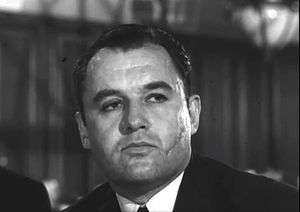Al Capone (film)
| Al Capone | |
|---|---|
.jpg) | |
| Directed by | Richard Wilson |
| Produced by |
Leonard Ackerman John Burrows |
| Written by |
Malvin Wald Henry F. Greenberg |
| Starring | Rod Steiger |
| Narrated by | James Gregory |
| Music by | David Raksin |
| Cinematography | Lucien Ballard |
| Edited by | Walter Hannemann |
| Distributed by | Allied Artists |
Release dates |
|
Running time | 104 minutes |
| Box office | $2.5 million (rentals)[1] |
Al Capone is a 1959 biographical film directed by Richard Wilson.[2] written by Malvin Wald and Henry F. Greenberg, and released by Allied Artists. It starred Rod Steiger as Al Capone.
Steiger reportedly refused the producers' first offer to star in this film because he thought the initial screenplay inappropriately romanticized Capone and criminality. In an interview Steiger said, "I turned the picture down three times." According to TCM, he agreed to play the role only after the producers agreed to rewrite.[2] The finished film was noted for its deglamorized portrayal of the subject.[3]
Plot
Chicago, 1919: A young Al Capone arrives to work for mob boss Johnny Torrio. He meets Torrio's top man, "Big Jim" Colosimo, who runs business and politics in the First Ward while secretly on Torrio's payroll.
Prohibition is enacted a year later, causing Torrio and other gangsters like Dean O'Banion, George "Bugs" Moran and Earl "Hymie" Weiss to compete for profits in bootleg liquor and beer. Torrio's rivals conspire to have Colosimo and his henchmen killed.
A reform mayor is elected, so Torrio and Capone change their base of operations to Cicero, a few miles away. Capone also has O'Banion killed and makes a play for Maureen Flannery, the widow of one of Colosimo's men.
Weiss and Moran return the favor by ordering Torrio to be shot. Capone retaliates by killing Weiss and forcing merchants throughout the city to pay for "protection." A sergeant in the Chicago police, Schaefer, is promoted to captain and vows to end the bloodshed and extortion and put Capone behind bars.
With the heat on from the cops, a crooked newspaperman named Keely tries to bribe Schaefer but fails. He persuades Capone to move to Florida until things cool down. From a safe distance, Capone masterminds the St. Valentine's Day Massacre, with several of Moran's men gunned down in a Chicago garage.
Capone and Moran call a truce, but when he learns Keely has been helping a Moran plot to kill him, Capone ends the reporter's life instead. Maureen finally has her fill of Capone's corruption and violence, while Schaefer and the feds find a way to finally put Capone away—on charges of tax evasion, earning him 11 years at Alcatraz.
Cast
- Rod Steiger as Al Capone
- Nehemiah Persoff as Johnny Torrio
- Fay Spain as Maureen Flannery
- Joe De Santis as Big Jim Colosimo
- Martin Balsam as Mac Keely
- James Gregory as Schaefer
- Murvyn Vye as Bugs Moran
- Sandy Kenyon as Bones Corelli
- Clegg Hoyt as Lefty (uncredited)
Reception
Bosley Crowther in The New York Times commented that with so many old movies about Capone, it was uncertain whether a new one was needed, but that this film had the "modest justification" that "it has a strong documentary flavor and Rod Steiger is an odious skunk in the title role."[4] Variety called it "a tough, ruthless and generally unsentimental account" and "also a very well-made picture."[5] The film won a Laurel Award as 1959's "Sleeper of the Year".[6]
Gallery
See also
References
- ↑ "1959: Probable Domestic Take", Variety, 6 January 1960, pg 34.
- 1 2 Axmaker, Sean. "Al Capone (1959)". TCM. Turner Entertainment Networks, Inc. Retrieved 20 June 2012.
- ↑ "Rod Steiger Plays Villain Again; Now He Deglamorizes Capone", Deseret News, May 30, 1959, p. 8A.
- ↑ Bosley Crowther, "Ancient History of 'Al Capone'; Steiger Takes Title Role at Victoria, Documentary Flavor Marks New Film", The New York Times, March 26, 1959.
- ↑ "Al Capone", Variety, December 31, 1958.
- ↑ 1959 Laurel Awards at IMDB.com.
External links
- Al Capone at the Internet Movie Database
- Overview and ratings from TCM


